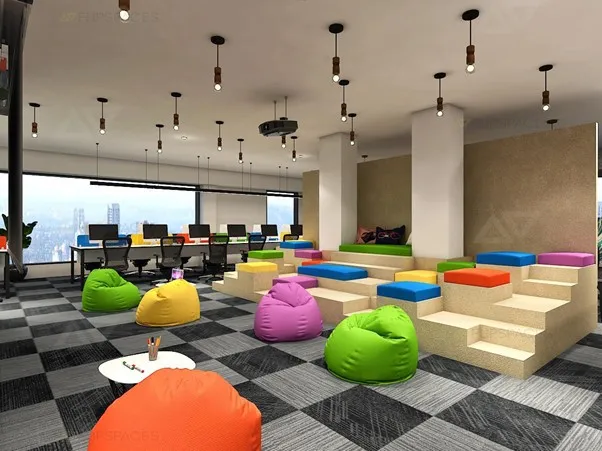COVID-19 brought in a paradigm shift in commercial real estate. With the receding effects of the pandemic, post mid-2021, coworking spaces started picking up pace as companies started becoming operational. In spite of the initial doubts about the future of the coworking sector, the segment has gained traction across all industries, making coworking spaces a preferred mode of workspace operation.
As per JLL research data, before the onset of COVID-19 during 2019, the office space market was spread across around 30 million sq ft. There has been an impressive growth of 117% since June 2022 in the industry. The biggest change that flexible spaces has seen is the influx of large corporations as tenants, with IT holding the largest space.
As the demand for customised solutions channels the operations of the industry, coworking spaces are the next big opportunity globally. Commercial interior designers are spending more time enhancing modern coworking spaces as they gradually shift from traditional offices.
Here are a few aspects that justify the shift from traditional units to more evolved coworking setups in the post-pandemic world.
Working near your home
Along with the famous trend of ‘working from home’, coworking spaces allow you to work ‘near’ your home. Larger cities have multiple coworking spaces at different locations for professionals to visit and work seamlessly. This is because, in the post-pandemic world, employees are no longer willing to travel long distances to work every day.
Coworking spaces provide you with an office-like atmosphere and amenities without the need to go to the office every day. This has made employees find a sweet spot between working from the office and working remotely by visiting coworking spaces near them.
Cost-effective solutions
With a dedicated working space, high speed internet, state-of-the-art facilities, conference and meeting rooms, ease of multiple locations, and flexible payment options with a no-strings-attached business plan, coworking spaces signal the best workplace evolution for startups.
Over time, more and more businesses are switching to coworking spaces to cut down their operational costs. Companies across the world have accepted that the trend of remote working is not going away. Now that most employees are working remotely, the management requires only a handful of professionals to be present on-premise.
Under such circumstances, instead of building a dedicated office space, working out of a coworking space is a more cost-effective alternative. Even if you have a hybrid workspace, you can always call your employees to a coworking space when they require to work from the office. This lets businesses save a fortune that can be spent on more important and productive areas.
Limited spaces across multiple locations
In the post-pandemic world, businesses are following the approach of ‘one floor in ten cities versus ten floors in one’. As the number of employees working from the office has reduced, it doesn’t make sense to dedicate a large office area for work. Instead, businesses with employees across multiple cities prefer working with limited coworking spaces in multiple cities.
This provides employees who are willing to work from an office the opportunity to work on-premise without the company spending a fortune to build multiple offices. As modern coworking spaces offer flexible accommodation, there is always scope for making necessary adjustments.
Bringing the community aspect back
While remote work thrived during the pandemic, professionals worldwide missed the ‘community’ aspect of working from offices. Working within the confinement of four walls led to severe burnout and reduced the productivity of many employees.
Modern coworking spaces allow employees to regain the lost community aspect by working around people. As most coworking spaces are designed using open-floor plans, communication and collaboration become easier. At the end of the day, it leaves an employee feeling less lonely as they are always surrounded by people they can interact with.
Coworking spaces help professionals exchange valuable ideas, have productive conversations, and resolve work-related issues by working in a community. Even if your employees are not working with their teams, they can always find companions to chat with in a coworking space.
Space for leisure
A lot of professionals overworked themselves while working remotely during the pandemic. As the lines between professional and personal time blurred, people started working for longer hours without any leisure. Now that things are back to normal, coworking spaces help your employees interact with each other, as they work on-premise.
Modern coworking spaces are equipped with common areas, cafés, and indoor games to help professionals unwind and take much-needed breaks. This prevents employees from working themselves to exhaustion, which could hamper their performance.

Increasing prominence of startups
With the government incentivising startups and small businesses, more and more entrepreneurs are entering the markets across all industries. These businesses are set up keeping in mind the modern workplace trends, allowing their employees to work remotely or through hybrid workspaces.
As startups and small businesses often struggle with budgetary issues, they resort to modern coworking spaces to conduct their operations. This makes their operations cost-effective and allows a small team of employees to work comfortably on-premise. With the emergence of more startups and SMEs, we are likely to see more coworking spaces being set up across the country.
No responsibility to manage premises
Looking back at the catastrophic impact of the pandemic on businesses, companies are no longer willing to take up the responsibility of managing the entire office premises by themselves. The management would rather focus on growing the business than looking after minute details while managing the offices.
Modern coworking spaces allow companies to shrug off the responsibility of managing the premises. As the space is rented and not owned by businesses, they no longer need to focus on matters related to sanitisation, catering, infrastructure, etc. The staff at the coworking space ensure that the premises are clean, sanitised, and equipped with all necessary amenities.
The final word
The pandemic has changed workplace norms forever, and it is important to get on the bandwagon of change to sustain. Modern coworking spaces have allowed businesses to steer away from the traditional approach towards designing and managing workplaces. Looking at the adoption of coworking spaces, it is safe to say that they are here to stay and are likely to see even more advancements in the years to come.
(The author is Founder and CEO of Flipspaces, a design-tech venture with tech-enabled solutions.)
(Disclaimer: The views and opinions expressed in this article are those of the author and do not necessarily reflect the views of YourStory.)










